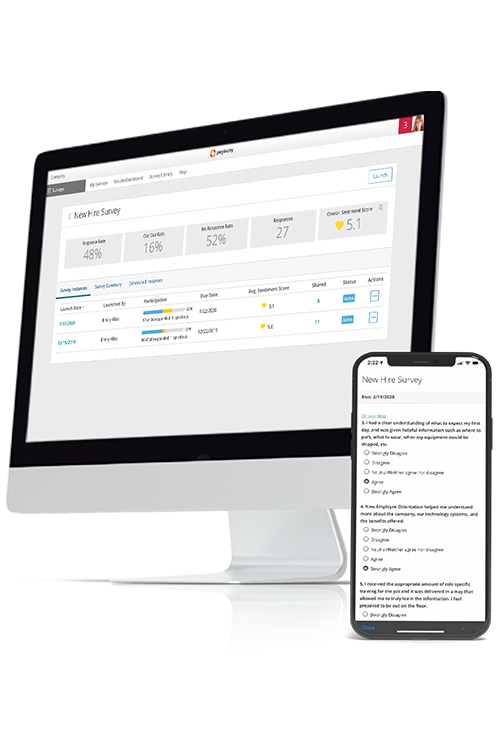
Why Employee Well-Being Needs a Simpler Approach
When you ask most leaders about employee wellness, you’ll likely hear a familiar story: the desire to support employee well-being is there, but delivering a program that’s impactful, consistent, and engaging is a different story.
Wellness programs often feel bolted on instead of baked in. They’re another item on an already packed HR agenda. And despite offering gym reimbursements, employee assistance programs (EAPs), or mental health resources, many teams still struggle with participation and impact.
So, how do modern businesses make wellness simpler and more meaningful?
They do it by building community, embedding wellness into the everyday employee experience, and using automation and AI to reduce the lift for HR.
It’s not about doing more, it’s about making wellness feel more natural. If accessing wellness-being resources or tracking goals is a hassle, employees won’t engage.
In our recent study of U.S. workers, 89% of employed respondents said mental health support is an important benefit.
Yet many organizations still rely on outdated tools or disjointed offerings. And when wellness feels like another job, participation drops. When it feels like support, it sticks.
Instead of one-off wellness campaigns, organizations should integrate well-being into the daily workflow. That means pushing nudges and reminders through the employee app, celebrating small wins socially through public recognition, and connecting wellness to broader HR functions like onboarding and performance.
Meeting employees where they are—on their phones, during the flow of work—reduces friction and increases participation.
1. Community is Key
For wellness programs to truly matter, they need to go beyond physical health and address emotional, financial, and social well-being. That includes helping employees feel connected and supported.
Wellness works best when it feels shared. Whether that’s company-wide step challenges, mindfulness breaks in a video feed, or healthy habits shared in a chat group, it’s about creating space for people to engage together.
For example, teams can use community groups to build support around mental health or parenting. These aren’t top-down initiatives, they’re peer-driven spaces that foster inclusion and trust.
2. Implement Accessible Digital Wellness Solutions
In our study, only 59% of employees said their company offers modern wellness solutions like mindfulness apps or virtual therapy, leaving a significant gap to fill. And while 77% believe their employer cares about their well-being, just 30% say they feel that strongly.
Recognition plays a role here too: nearly half (49%) of employees say their contributions go unrecognized. Embedding wellness into daily tools and tying it to recognition systems helps employees feel seen and valued.
One major reason wellness programs fall short is simply bandwidth. Employers don’t have the time to manage spreadsheets, send reminders, or track every employee milestone manually.
That’s where automation can help.
3. Build Wellness into Existing Programs
Today’s HR tools can trigger wellness challenges during onboarding, automatically enroll employees in programs based on life events, and prompt managers to check in during high-stress seasons. AI can even surface engagement insights to help employers proactively support at-risk teams.
When wellness becomes a seamless part of work, not a separate track, it starts to deliver real results. Companies see better participation, higher engagement, and stronger retention. And employees feel supported, not just in their roles, but as whole people.
4. Healthy Employees are Good for Business
Employees don’t expect perfection, but they do expect their employer to care, and to make that care easy to access. Our research found that 87% of employees would even prioritize flexible schedules over higher pay, signaling just how much work-life balance and well-being matter.
Ultimately, the future of wellness won’t be defined by flashy programs or expensive perks. It will be shaped by simplicity, consistency, and culture.
If wellness feels easy, employees will engage. And when employees are well, businesses thrive.
How Paylocity Makes Employee Well-Being Seamless
With the right tools and mindset, employee well-being doesn’t have to be complicated, it just needs to be intentional.
Paylocity helps organizations embed wellness into the everyday employee experience with features like:
- Community: Streamline communication, connect with employees, and foster a culture of engagement.
- Recognition and Rewards: Craft customized recognition programs, offer diverse rewards, manage budgets, and track program metrics in real-time.
- Employee Voice: Automatically collect feedback that's indicative of engagement and retention. Gain insights, uncover strengths and opportunities, and create action plans to improve.
By meeting employees where they are and making support accessible, Paylocity empowers HR teams to create a culture where well-being isn’t an afterthought.
Want to learn more? Request a demo!




